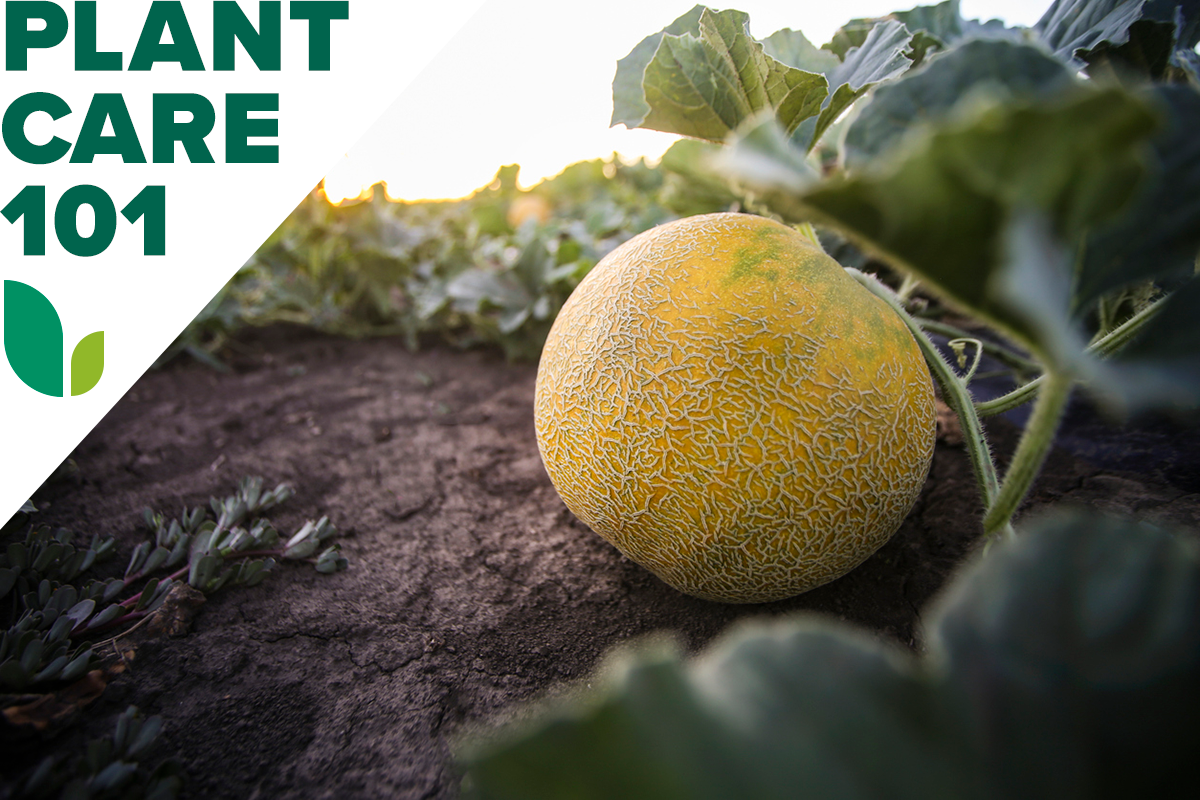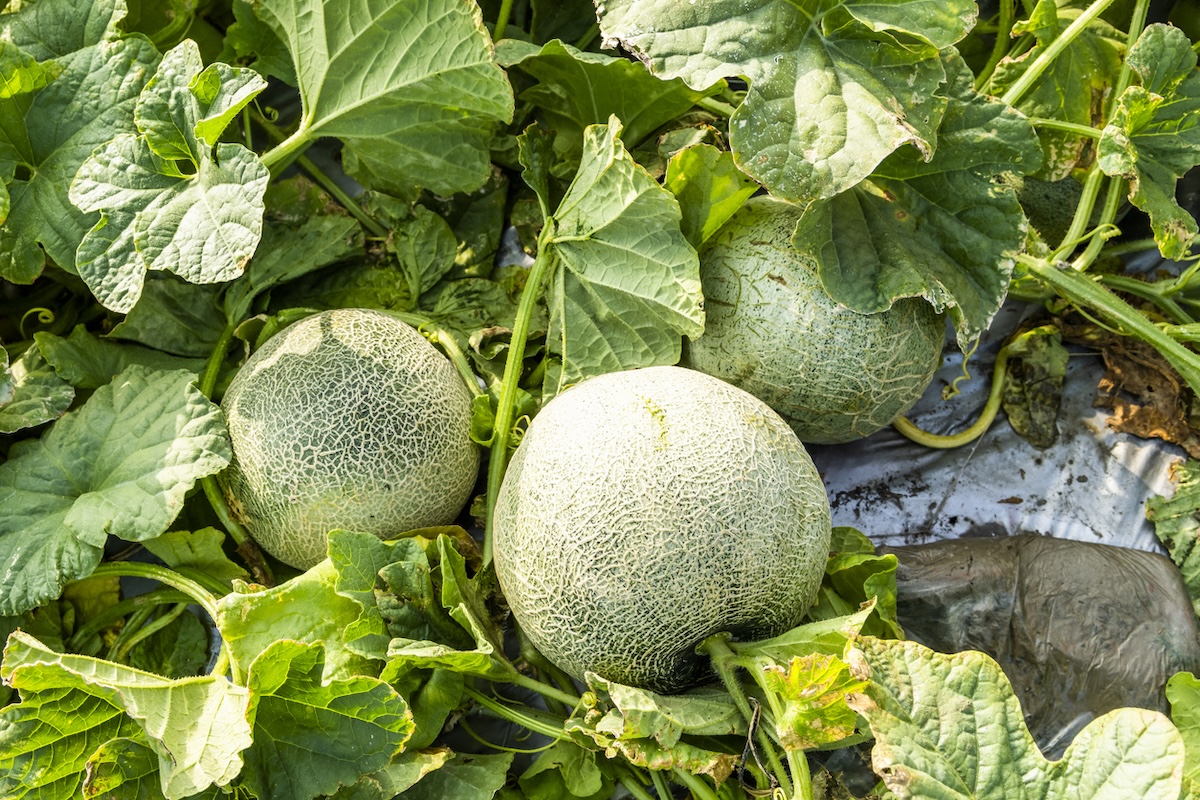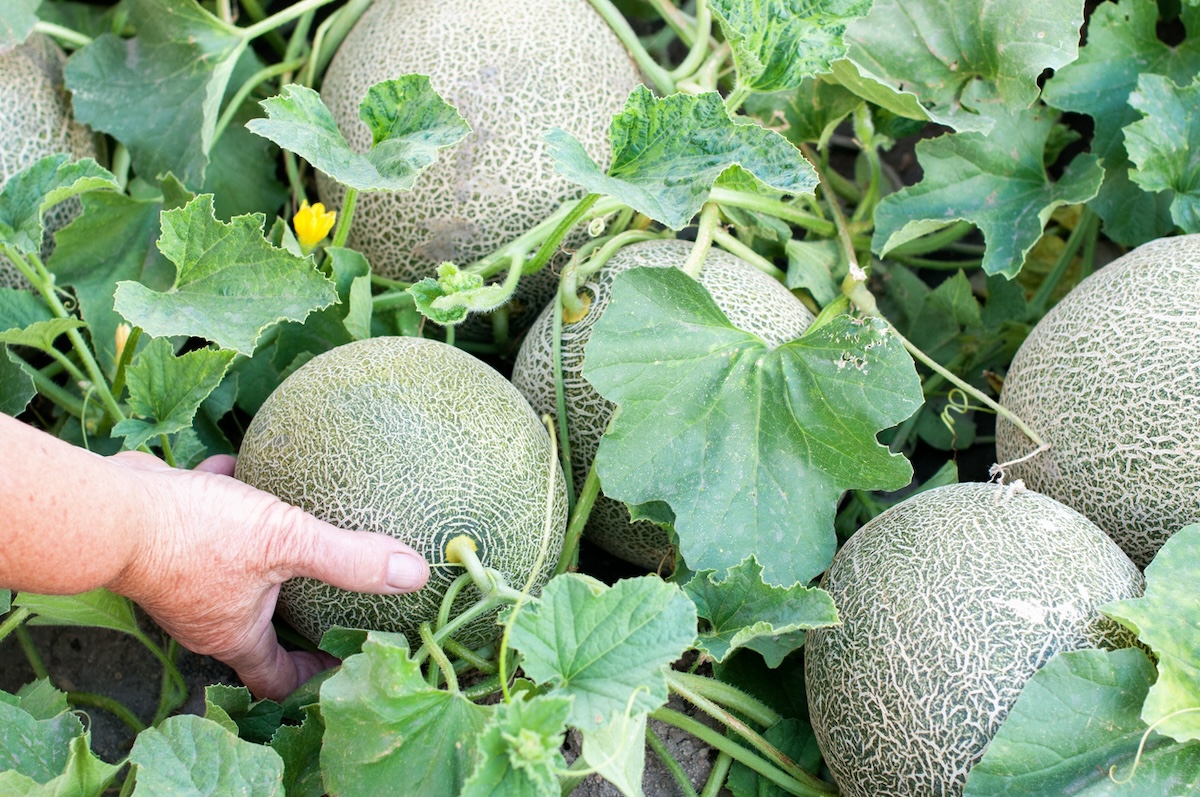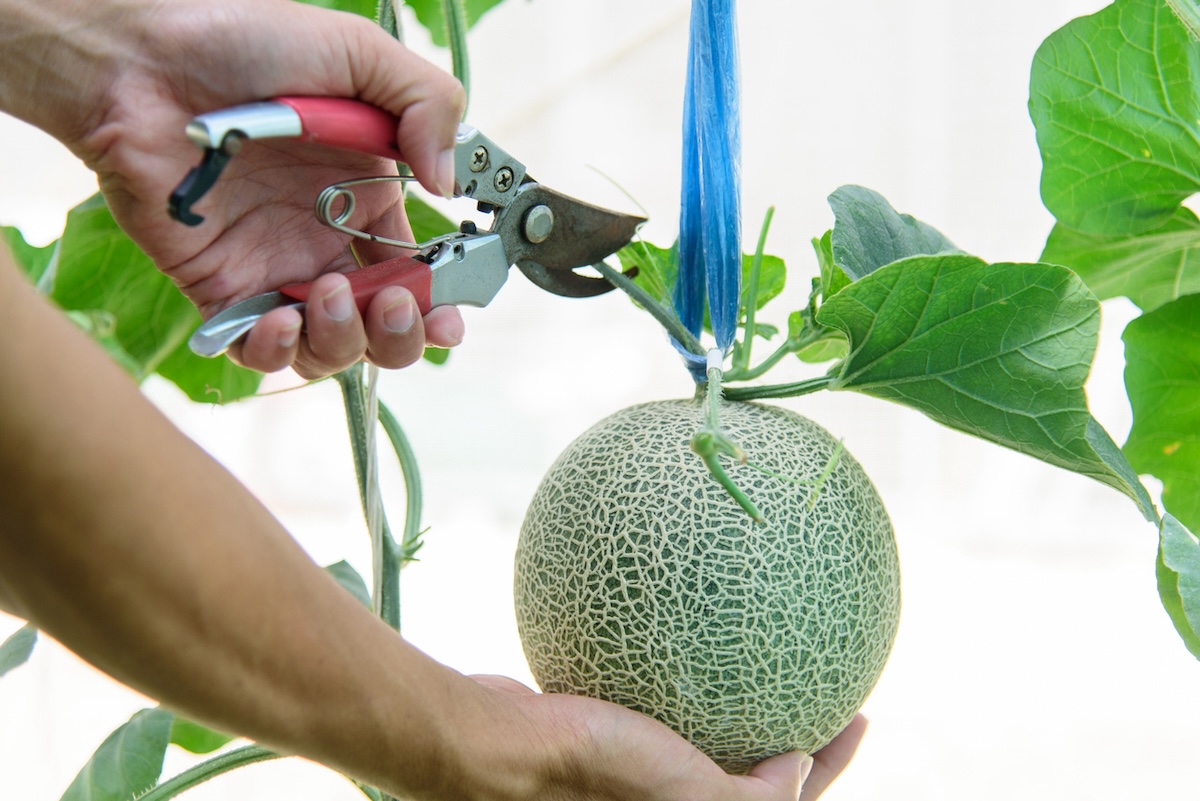

We may earn revenue from the products available on this page and participate in affiliate programs. Learn More ›
Because the true cantaloupe plant (Cucumis melo var. cantalupensis) is a hard-shelled or warty European fruit seldom grown in the U.S., this article actually focuses on muskmelon (Cucumis melo var. reticulatus). It has a netted-looking rind and often is called cantaloupe these days, but the care for both types of melon is the same.
When considering how to grow cantaloupe, keep in mind that it requires at least 2½ months of summery weather to mature properly, preferably 4 months. However, gardeners in the north stretch their season with the use of transplants, black plastic mulch, and row cover.
Growing Cantaloupe at a Glance
Common Name: Cantaloupe, muskmelon
Scientific Name: Cucumis melo var. reticulatus, Cucumis melo var. cantalupensis
Hardiness Zone: Annual
Soil: Sandy, well-drained loam
Light: Full sun
Water: Medium
Food: Organic vegetable fertilizers
Propagation: Seed
Safety: Edible fruit
Cantaloupe Characteristics
A cantaloupe vine can sprawl or climb 6 to 9 feet in length and 3 feet in width. It has 3-inch-long and up to 6-inch-wide hairy and frequently shallowly lobed leaves. It makes yellow male and female flowers over 1 inch in diameter, with the male type usually appearing first on thin stems in clusters.
The solitary female blooms each have a swelling beneath the flower, which will transform into a cantaloupe fruit after that flower is pollinated. Mature cantaloupe fruits vary from 6 to 10 inches in length and 1 to 11 pounds in weight and usually have a beige netted-looking rind and orange flesh.
If it doesn’t shade their vines, sweet corn often makes a good companion plant for melons that can crawl around its “ankles.”

Recommended Cantaloupe Varieties
- Athena: This F1 hybrid melon declares war on fusarium wilt disease and powdery mildew, and makes 5 to 6 pound fruits in 79 days.
- Hale’s Best Jumbo: One of the most popular open pollinated cantaloupe types, this hale cultivar produces hearty 5 to 6 pound melons in about 85 days.
- Sarah’s Choice: Whoever Sarah was, she probably chose this F1 hybrid because it also is resistant to fusarium wilt and powdery mildew, rates high in taste tests, and produces 3 pound melons in 76 days.
Planting Cantaloupe
To prevent disease, avoid planting cantaloupe where other cucurbits, such as cucumbers, squash, or other melons, have grown during the last 3 years.
When is the best time to plant cantaloupe?
You can get a head start on the season by planting cantaloupe seeds indoors in peat pots 2 to 6 weeks before the last frost date. Alternatively, sow them directly in the garden about 2 weeks after that last frost date when the soil temperature has risen to at least 65 degrees.
Where can cantaloupe grow?
Cantaloupes will need 8 to 10 hours of sun per day. They also require fertile, well-drained soil with a pH between 6 and 6.5. To provide adequate drainage in heavy clay soils, grow melon plants either in raised beds or atop hills. Gardeners with sandy loam generally can allow the vines to creep along the ground instead.

How do you plant cantaloupe?
Keep in mind that black plastic mulch may generate too much heat for gardeners in the south.
- Two weeks before you plan to sow or set out your melons, create hills 6 to 8 inches tall, 3 feet wide, and 3 feet apart.
- Cover those hills with black plastic mulch in the north to heat up the soil quickly.
- Two weeks later, cut holes in that mulch with a bulb planter or garden shears before inserting transplants or sowing seeds.
- If sowing, plant four or five melon seeds atop each hill, ½ inch deep in clay soil, 1 inch deep in sandy ground.
- Once the seedlings are growing, leave only the two strongest in each hill and snip off the others.
- Cantaloupe spacing should be at least 2 feet when the vines are planted in rows.
Can you grow cantaloupe in containers?
You can grow a small melon vine, such as ‘Lil Loupe’, in a container like a half barrel or large grow bag but probably will need to train it to run up a trellis in that container. Make sure to support the fruits with cloth slings tied to the trellis or they will tear free of the vine once they put on weight.
Watering Cantaloupe
When growing cantaloupe, keep in mind that melons will require at least 1 inch of water per week, possibly up to 2 inches in fast draining soils, preferably provided via drip irrigation or a soaker hose to avoid wetting the foliage. Make sure that moisture reaches a depth of at least 6 inches.
You can mulch the plants to retain moisture, but don’t apply organic mulch until after the soil heats to 75 degrees, or it may keep that soil too cool. Once cantaloupe fruits begin to ripen, stop supplemental irrigation, which can dilute their flavor.

Fertilizing Cantaloupe Plants
If possible, apply compost or composted manure to your melon patch in the autumn before you plant it. Just before sowing or transplanting your melons, work an organic vegetable fertilizer such as 3-4-4 into the soil at the rate of 1½ pounds per 25 square feet, mixing it into the upper 5 inches of that soil.
Water your cantaloupe seedlings or transplants with a high-nitrogen liquid fertilizer, such as a 5-1-1 fish emulsion, following the directions on the bottle. It is recommended to do this once every 6 weeks until they begin to bloom. At that point between two cantaloupe growing stages, you should stop applying the nitrogen fertilizer.
Pollination
If you think the bees aren’t adequately pollinating your melon blossoms, which can happen during cool or rainy periods, you can try hand pollination in the early morning of a dry day. According to the University of Utah, you should simply use an artist’s brush to collect pollen from the stamen of one of the thin-stemmed male flowers and—using a swirling motion—apply that pollen to the stigmas of the female flowers. Each of those female flowers will usually swell and produce a small ball beneath its bloom.
Safety Considerations
Although melon flesh is edible, it can be contaminated by salmonella and E. coli bacteria, which usually originate on the rind and spread to the flesh via knife cuts. For that reason, don’t leave cut melon standing in a warm place where bacteria can multiply quickly. Instead, place it in the refrigerator since lower temperatures slow bacteria growth. Also, only cut a melon with a clean knife after you have scrubbed the outer rind thoroughly with a vegetable brush under running water.
Potential Pests and Diseases
Melons often suffer from bacterial wilt diseases carried by insects such as cucumber beetles. To help prevent those maladies, top your melon plants with a floating row cover immediately after you transplant them into the garden or soon after they emerge from the soil for direct-sown plants.
That topper also will help protect them from unexpected late frosts and keep them a few degrees warmer than they otherwise would be. You will need to remove the cover once the plants begin to bloom to allow them to be pollinated. Keep in mind that hybrids tend to be more disease-resistant than open-pollinated melons.
Harvesting Cantaloupe
Not all of your melons will ripen at the same time, so you will need to watch for certain signs.
When is the best time to harvest cantaloupe?
Cantaloupes typically mature 35 to 45 days after the plant’s bloom time. The rinds of ripe melons should have turned from green to beige with their netting more pronounced and their tendrils having dried to brown. Those melons also will have developed a fruity fragrance and will detach easily from the vine when they are ready.

How do you harvest cantaloupe?
You won’t need any tools other than your fingers to harvest melons that are fully ripe.
- Test a cantaloupe for ripeness by tugging on it gently.
- If it immediately detaches from the stem, it is ripe.
- If it holds on, it probably needs to mature a bit more.
How do you store cantaloupe?
If you store an uncut melon in the crisper door of your refrigerator, it should last for 5 to 15 days. Cut melon should not be left out of the refrigerator for longer than 2 hours. Don’t store cantaloupe with other produce, such as salad greens, which are adversely affected by ethylene.
Looking for more vining fruits and vegetables? Check out our guides on growing cucumber, squash, and watermelon.
